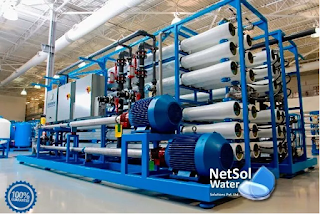Approaches to increase the effectiveness of water treatment plants
Municipalities are under more pressure than ever to handle water effectively because of the worldwide water issue. Operators of water treatment plants should constantly assess the plant's efficacy in treating water and make sure that systems are using the latest in equipment and technology. It may be quite expensive when water treatment plants are not running effectively. Higher running expenses and reduced income can have a detrimental effect on a treatment plant's bottom line because of ageing, inefficient pumping and processing equipment as well as out-of-date water management techniques.
Water treatment facilities can improve water efficiency and
gain possible cost savings by following the five procedures listed below.
Promoting, setting, and achieving performance goals have all
become a priority in the sector as a result of benchmarking. In addition to
assisting managers and regulators in recognising past trends, it also aids in
establishing a baseline performance for today and quantifies relative
performance across utilities so that future plans may be made. Operators of
water treatment plants should start by completing the self-assessment provided
by the Water Resource Foundation (WRF), which is included in the publication
Performance Benchmarking for Effectively Managed Water Utilities. Companies may
utilise the self-assessment to pinpoint performance gaps and create plans to
solve them.
Evaluate technology
After
determining the efficacy of present water practises, the next logical step is
to assess the water production technology. For instance, the majority of
surface water treatment facilities use a water filtering process that may
quickly use up a lot of water and energy. Because of this, it's crucial to
perform a technology audit to make sure infrastructure is running effectively.
Today's market is flooded with filter technology that uses less backwash water,
but equipment in water treatment facilities that has been in place for five to
ten years may be using more backwash water than is necessary. Managers of
treatment facilities should assess current technology and, if necessary,
replace it with effective goods and services.
Conduct
a pump audit
Pumps
are a common component of the process technologies utilised for water. Designing
pumps based on the peak plant flow is a common practise, especially in plants
over ten years old. However, in fact, these pumps work at a variable flow
depending on seasonality and system demand. Because of this, many pumps are
large. Constant speed pumps that run in an on-and-off manner waste energy and
water by using more water than is necessary. To decrease water loss, energy
use, and pump wear and tear from frequent on-off cycling, facilities should
refit existing constant speed pumps with variable frequency drives (VFDs).
Set
up intelligent technology
Water
treatment facilities should think about installing smart metering technologies
to monitor their distribution network when it comes to water management
techniques. This can reduce water waste that is not profitable. Utility
companies may assess performance and improve their infrastructure with the use
of smart technologies like Automated Meter Reading (AMR) systems and Advanced
Metering Infrastructure (AMI). AMR streamlines and enhances the accuracy of
data gathering by automatically collecting consumption, diagnostic, and status
information from water metres without the need for a manual metre read. When
combined with analytics, the data can assist utilities and their customers in
more effectively managing water consumption. Compared to AMR, which uses smart
metres, communication networks, and data, it is a more reliable option.
View
the information
The
data must be accessed and analyzed in order to evaluate infrastructure
performance and determine what changes must be made in order to increase
efficiency. It's crucial for treatment plant managers to make sure they are
measuring and monitoring the correct efficiency criteria because many water
treatment plants were established without much care about data collecting.
Observing for leaks in the distribution network, tying backwash water rates to
filter quality output, sludge thickening rates, and smart pump operation with
VFDs are all crucial efficiency characteristics. Operators of water treatment
plants should regularly assess their water management strategies to make sure
the facility is functioning profitably, reducing energy costs and enhancing
water conservation initiatives.
Call
Us for Support
We
are the manufacturers and service providers of all the water solution equipment.
Tell us how we can support you with your next project.
To get in touch with
us and to relish the benefits of our services, call
us at +91-9650608473 or send an email to enquiry@netsolwater.com

Comments
Post a Comment